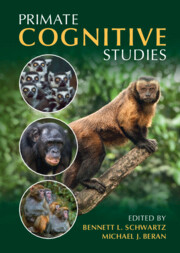Book contents
- Primate Cognitive Studies
- Primate Cognitive Studies
- Copyright page
- Contents
- Figures
- Tables
- Contributors
- Acknowledgments
- 1 The Purpose of Primate Cognitive Studies
- 2 A History of Primates Studying Primates
- 3 Genetic and Environmental Influences on Chimpanzee Brain and Cognition
- 4 The Evolution of Cognition in Primates, Including Humans
- 5 State of the Field
- 6 Current Perspectives on Primate Perception
- 7 The Comparative Study of Categorization
- 8 Numerical Cognition in Nonhuman Primates
- 9 The Natural History of Primate Spatial Cognition
- 10 Progress and Prospects in Primate Tool Use and Cognition
- 11 Sequencing, Artificial Grammar, and Recursion in Primates
- 12 The Evolution of Episodic Cognition
- 13 Metacognition
- 14 Bridging the Conceptual Gap between Inferential Reasoning and Problem Solving in Primates
- 15 The Eyes Have It
- 16 Social Cooperation in Primates
- 17 Primate Communication
- 18 Theory of Mind in Nonhuman Primates
- 19 A Requiem for Ape Language Research
- 20 Primate Empathy
- 21 Replication and Reproducibility in Primate Cognition Research
- 22 Ethical Considerations in Conducting Primate Cognition Research
- 23 Collaboration and Open Science Initiatives in Primate Research
- 24 Studying Primate Cognition
- 25 Do Monkeys Belong in the Ape House?
- Index
- References
10 - Progress and Prospects in Primate Tool Use and Cognition
Published online by Cambridge University Press: 28 July 2022
- Primate Cognitive Studies
- Primate Cognitive Studies
- Copyright page
- Contents
- Figures
- Tables
- Contributors
- Acknowledgments
- 1 The Purpose of Primate Cognitive Studies
- 2 A History of Primates Studying Primates
- 3 Genetic and Environmental Influences on Chimpanzee Brain and Cognition
- 4 The Evolution of Cognition in Primates, Including Humans
- 5 State of the Field
- 6 Current Perspectives on Primate Perception
- 7 The Comparative Study of Categorization
- 8 Numerical Cognition in Nonhuman Primates
- 9 The Natural History of Primate Spatial Cognition
- 10 Progress and Prospects in Primate Tool Use and Cognition
- 11 Sequencing, Artificial Grammar, and Recursion in Primates
- 12 The Evolution of Episodic Cognition
- 13 Metacognition
- 14 Bridging the Conceptual Gap between Inferential Reasoning and Problem Solving in Primates
- 15 The Eyes Have It
- 16 Social Cooperation in Primates
- 17 Primate Communication
- 18 Theory of Mind in Nonhuman Primates
- 19 A Requiem for Ape Language Research
- 20 Primate Empathy
- 21 Replication and Reproducibility in Primate Cognition Research
- 22 Ethical Considerations in Conducting Primate Cognition Research
- 23 Collaboration and Open Science Initiatives in Primate Research
- 24 Studying Primate Cognition
- 25 Do Monkeys Belong in the Ape House?
- Index
- References
Summary
We review the main ecological and socio-cognitive hypotheses explaining the origin and evolution of tool use in primates. Whereas it is clear that recent studies have deepened our understanding of tool use in several domains, a more integrated approach will be necessary to further advance the field and place this information into a broader evolutionary context. We suggest a combined Comparative Socio-ecological and Developmental Approach (CSDA), which incorporates phylogenetic and ontogenetic perspectives with the ecological and socio-cognitive drivers of tool use as a means to clarify the integrated mechanisms that promote the emergence and maintenance of tool-using skills in primates, including humans.
- Type
- Chapter
- Information
- Primate Cognitive Studies , pp. 238 - 259Publisher: Cambridge University PressPrint publication year: 2022
References
- 2
- Cited by

